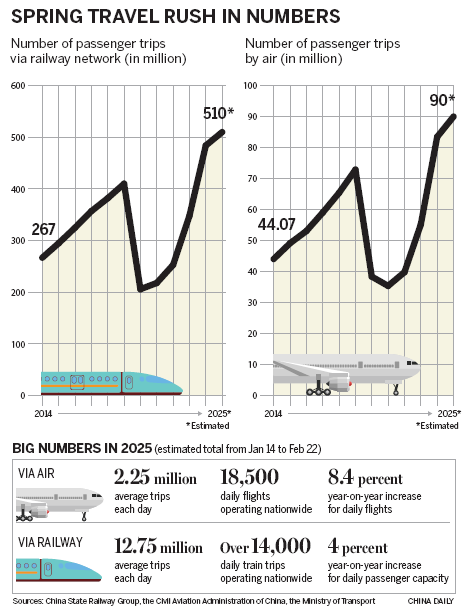Chunyun: Tradition on the fast track
Management, transformation of Spring Festival travel rush a microcosm of China's modernization efforts


Reshaping of transportation
Although the large migration put tremendous pressure on China's transportation systems, its transportation landscape has undergone a dramatic transformation in recent decades, reshaping the world's largest annual migration.
In 1980, the term "chunyun" was introduced to the public when it was featured in People's Daily.
Shortly before that, in 1978, China's road network was 890,000 kilometers, and its railway network was 52,000 km, with no high-speed rail or expressways. At the same time, China had 78 civil aviation airports.
By the end of 2024, the road network had expanded to over 5.4 million km, including 190,000 km of freeway, while the railway network covered 162,000 km — nearly 48,000 km of which are designated for high-speed rail. And the number of civil aviation airports had increased to 284.
"This massive expansion of infrastructure has translated directly into increased transport capacity, which is critical in alleviating the pressures of chunyun," said Xie, the researcher from AMR.
Professor Ji from Beijing Jiaotong University agreed. "The development of high-speed rail has been a game changer," the professor said. "Once hampered by mixed passenger and freight operations, the rail system now features dedicated high-speed lines that significantly cut travel times and improve service quality. These high-speed trains have not only enhanced safety and comfort during peak travel periods, but have also redefined the very experience of holiday travel.
"China's national governance system has enabled rapid railway expansion within just a few decades, with the rail network serving as a vital pillar of the country's infrastructure during major challenges such as chunyun," Ji added.
Apart from infrastructure expansion, the mobilization of national resources to ensure efficient services is also key. Unlike some countries where Christmas traffic congestion is largely an individual concern, in China, the government actively mobilizes resources to manage and ease travel pressures, Xie noted.
"When highways experience heavy congestion, government departments and service providers respond swiftly to ensure smooth travel. This high level of coordination makes chunyun not just a logistical challenge, but also a nationwide priority," she said.
Xie's insight has been proven by the extensive measures taken to manage chunyun's enormous scale. The sheer number of travelers places immense pressure on China's transportation networks.
According to the Ministry of Transport, during this year's chunyun, railway and air travel will hit record highs with over 510 million and 90 million trips, respectively. Road travel in private vehicles remains the dominant form of travel, accounting for approximately 80 percent of all cross-regional trips at an estimated 7.2 billion journeys. The rest may travel by waterway and long-distance buses.
Recognizing the significance of chunyun, the government has taken a proactive approach to ensure smooth operations.
As early as Dec 31, 2024, a national teleconference on the 2025 Spring Festival travel rush was held in Beijing. A special chunyun task force composed of workers from the National Development and Reform Commission, the Ministry of Public Security, the Ministry of Transport, the Ministry of Emergency Management, the China Meteorological Administration, the Civil Aviation Administration of China and China State Railway Group was established to coordinate efforts across multiple sectors.
This high-level inter-agency collaboration is a reflection of China's modernization and its capacity for large-scale logistical management. The highly organized management mechanism — by government agencies and enterprises — strives to ensure people can travel home smoothly.
Since any incident on the roads would draw nationwide attention during the period, transportation authorities face the greatest scrutiny and pressure. Many industry professionals and workers sacrifice their reunions with family and friends so they can make sure things go well.
Dedicated staff, innovations
Behind the scenes of the massive migration is an army of dedicated professionals who ensure the smooth operation of the transportation network.
"During chunyun, almost everyone in the transportation industry is on duty," said Liu Dongmei, a researcher from the Research Institute of Highway under the Ministry of Transport. "From government departments such as the Ministry of Transport and local transportation bureaus, to service providers and even road maintenance crews, everyone is working overtime. Transportation companies and their employees are also fully mobilized. It's a massive collective effort."
As transportation workers remain on duty, foregoing their own reunions, their commitment helps ensure that millions of others can reach their families on time. Through their dedication, the massive movement of people across the country is transformed from a logistical challenge into a well-coordinated national effort.
As urbanization, high-speed rail expansion and evolving work cultures are reshaping China, chunyun will change for the better, transforming from a logistical challenge into a more relaxed and enjoyable travel experience. However, as long as family reunions remain at the heart of Chinese tradition, the holiday travel rush will continue to be a defining annual event.
Experts predict that technological advancements and shifting travel patterns will play a pivotal role in shaping the future of chunyun.
"Digitalization and green technologies are already transforming the way people travel," said Xie, from AMR. "In the future, more advanced transportation methods such as low-altitude flight systems could revolutionize the Spring Festival travel rush, making it faster and more efficient."
Liu Dongmei highlighted the growing demand for travel during chunyun.
"As living standards improve, people's travel aspirations — whether for family reunions or tourism — will continue to rise," she said. "While some might expect demand to decrease due to more flexible vacation schedules, current data still shows an upward trend."
Liu Xin, a researcher from the China Academy of Transportation Sciences, emphasized the impact of smart technologies.
"Since the pandemic, innovations like facial recognition and the adoption of e-tickets have made travel more efficient and contactless," he said. "Big data platforms such as the 12306 railway system allow us to predict travel patterns, allocate resources effectively and ensure a smoother passenger experience."
For now, as billions board trains, planes and buses, the evolution of chunyun is not just about moving people, but moving them better, faster and smarter.
After years of development, chunyun is no longer as burdensome or challenging as in the past, but is now a more relaxed experience, reflecting China's unique path to modernization as it balances the demands of a mobile society with the enduring values of family and tradition.
"The future of chunyun will blend tradition with innovation, ensuring that the journey home remains as meaningful as the reunion itself," Xie said.
luowangshu@chinadaily.com.cn























